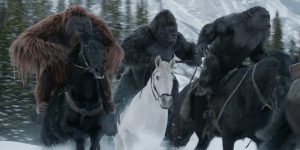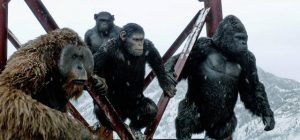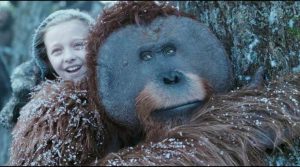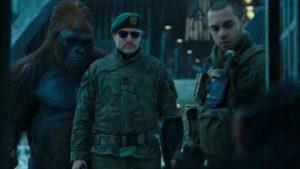 If you read this blog, you may recall that Part Four in this series appeared a little over a year ago. At that time War for the Planet of the Apes, the ninth film in the franchise and the third in the latest reboot, had not yet been released. It came out later that summer, and I saw it then but chose not to write about it until I watched it at least one more time, which I did last week. (In sequence with the first two, of course.)
If you read this blog, you may recall that Part Four in this series appeared a little over a year ago. At that time War for the Planet of the Apes, the ninth film in the franchise and the third in the latest reboot, had not yet been released. It came out later that summer, and I saw it then but chose not to write about it until I watched it at least one more time, which I did last week. (In sequence with the first two, of course.)
The consensus: it is a brilliant film, both uplifting and heart-wrenching, and actor Andy Serkis’s third go-around as Caesar, the leader of the intelligent apes, is Oscar-worthy, I kid you not. For a change I agreed with the critics, whose aggregate score for War on Rotten Tomatoes was 93%. It was a fitting conclusion to both the trilogy and the franchise…if indeed the series is done. More on that later.
FOR FREEDOM. FOR FAMILY. FOR THE PLANET.
With that tagline—and no spoiler alert—here is a brief synopsis of the first half of the film. The story resumes about two years after Dawn of the Planet of the Apes. Still in their woodland sanctuary, Caesar and his band are hunted endlessly by a rogue paramilitary faction called Alpha-Omega. Their leader, known only as The Colonel (Woody Harrelson at his creepy/psycho best), is obsessed with annihilating the apes. Oddly, he utilizes a number of apes that have deserted Caesar. The humans call them “donkeys,” a derogatory term.

The Colonel and Caesar are each other’s worst nightmares.
An attack on an ape outpost goes badly for a small squad of humans, and most are killed. The apes capture four men, plus a turncoat gorilla named Red. In an effort to show The Colonel that the apes would prefer peace, Caesar releases the soldiers but hangs on to Red. Before he can decide what to do with the captive, Red apparently overpowers an albino gorilla named Winter and escapes. Later, it will be revealed that Winter aided in his escape after the albino betrays the apes.
Caesar’s older son, Blue Eyes, and one of his lieutenants, Rocket, return from a journey and report that they found a place to the east that would be a perfect safe haven for the apes. Before they can leave, a team of soldiers—led by The Colonel—attacks the village. Caesar stands face to face with his enemy for the first time, then watches in horror as The Colonel kills his wife, Cornelia, and Blue Eyes. He pursues The Colonel but is nearly killed in the attempt.
THE GIRL WHO COULD NOT SPEAK

Maurice, Luca, and Rocket would give their lives for Caesar.
Having always taken the higher road of diplomacy, Caesar now becomes obsessed with killing The Colonel. Ordering his band to travel to safety he sets off alone toward the Sierras, but he is soon joined by Rocket and Maurice, the gentle orangutan, as well as a gorilla lieutenant named Luca. As snow falls they first come across an abandoned human village, where they are forced to kill a deserter when he attacks them. Exploring the ruins they find a young, mute girl. Not wanting her to freeze to death there, the kind-hearted Maurice “adopts” her. Later on he will name her Nova—an homage to the character of the same name in the original Planet of the Apes film. Nova’s subsequent role will be key to the story.
Traveling farther into the Sierras, they come across a military encampment and find Winter, who has become a “donkey,” in a tent. He tells Caesar that The Colonel left for the border, where he will meet more soldiers. When Winter tries to call out for help, Caesar suffocates him. They then discover that a number of soldiers have been staked out in the snow and executed—by order of The Colonel himself. One of the men, barely alive, tries to speak, but he has become mute. Caesar mercifully ends his suffering.

Caesar and his band look for the border.
BUILD THAT WALL
Uncertain where “the border” is, the apes climb an electrical tower to get their bearings. Below, one of their horses is stolen by a hooded figure. They pursue the perpetrator and corner him at an abandoned ski resort. He is a chimpanzee named Bad Ape—the derogatory name, he explains, is what humans used to yell at him when he was in a zoo. Self-taught, he speaks quite well. Yes, he knows where the border is, but he is terrified of the quarantine facility that existed there during the dark days of the Simian Flu pandemic that wiped out much of the world’s population. Ultimately, he agrees to take them there, if for no other reason than the companionship that this hermit has been lacking.

Maurice takes good care of Nova.
As they near the border, the quarantine facility becomes visible from a distance. Before they can continue, a small band of soldiers attacks them. They destroy the humans, but not before Luca is killed protecting Caesar. The apes and Nova are devastated. Caesar orders his group to hang back as he approaches the facility alone.
Closer now, Caesar is stunned by what he discovers. His entire band of apes, including Cornelius, his young son, have been captured. The quarantine facility has been turned into a labor camp, and The Colonel, fearing an even more superior military force coming to destroy him, has ordered the construction of a gigantic wall to keep his enemies out. (A crazed leader demanding a massive wall to be built? Couldn’t happen in the real world—could it?) The apes work long hours, with no food or water, and are suffering greatly.
Caesar cannot believe what he is observing. Intent on the scene, he does not notice until the last moment that Red, the “donkey” gorilla, has snuck up behind him. Then, everything goes black…

The Colonel brings to mind another officer of the same rank…named Kurtz.
I’ll stop here, and yes, this is about halfway through the film. I found War for the Planet of the Apes…well, mesmerizing, the best word I can use to describe the entire movie, especially what is yet to come. If this is to truly be the end of the fifty-year-old franchise in general, and the last three films in particular, then as I said before, they could not have brought it to a conclusion any better than with this gem.
But will there be more? I learned that, about two years ago, another sequel was being “discussed.” Yeah, but as I said last week about San Andreas, I’ll believe that when I’m on my way to the local Cinepolis to see it. One can only hope.
